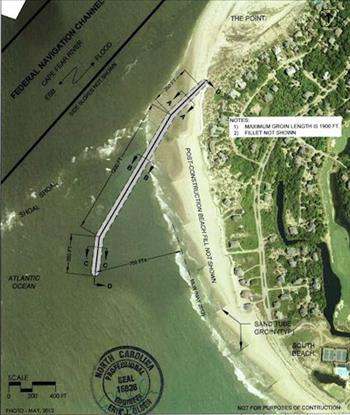BALD HEAD ISLAND — The Village of Bald Head Island has applied for a state permit to build a terminal groin.
The village submitted a Coastal Area Management Act major permit application with the N.C. Department of Environment and Natural Resources Aug. 1, the same day the Army Corps of Engineers released a copy of its final Environmental Impact Statement for the proposed project.
Supporter Spotlight
With funding for a terminal groin secured through an $18 million bond, Bald Head Island could be the first coastal community in North Carolina to build a groin since state lawmakers in 2011 reversed a regulation banning the construction of hardened erosion-control structures along the coast.
That year, the N.C. General Assembly passed a bill allowing no more than four permits to build terminal groins.
Before building can begin, the village must clear a number of hurdles.
 Bald Head Island property owners want to build a terminal groin almost 2,000 feet long at the western end of South Beach to control erosion. They could become the first community to build a groin since state lawmakers in 2011 reversed a regulation banning the construction of hardened erosion-control structures along the coast. Photo: Village of Bald Head Island |
CAMA major permits are reviewed by 10 state and four federal agencies. The CAMA process allows the agencies up to 75 days to review major permit applications.
“A decision could be made as early as 75 days from now,” said Michele Walker, a spokeswoman for the N.C. Division of Coastal Management. “Obviously, it could be done before that. I imagine we’ll be taking our time. If we need more time we can extend that for an additional 75 days.”
Supporter Spotlight
Reviewing agencies will have to adhere to specific legislative requirements pertaining to terminal groins, including a stipulation that local governments get voter approval to fund the costs of building the structures.
“I imagine the review process will be somewhat different because we have the legislation to follow,” Walker said. “It’s going to be a little bit different from a CAMA major. It’s going to be more involved. This is the first one of these that we’ve done. We’ll be very careful and measured about how we do it.”
Both the Department of Environment and Natural Resources and the Corps have opened public comment periods. The Division of Coastal Management’s official comment period runs through Aug. 21, though comments will be accepted up until the time of the permit decision, Walker said.
The Corps will take comments on the final Environmental Impact Statement through Sept. 21.
The environmental study includes six alternatives. The preferred alternative is to build a 1,900-foot-long terminal groin to reduce sand loss at the western end of South Beach, the Point and West Beach, all of which have experienced persistent erosion over the past two decades.
The plan also calls for the village to maintain a portion of 16 textile tubes filled with sand along the westernmost portion of South Beach. The tubes, spanning anywhere from 250 feet to 350 feet long, were initially built in 1995, then entirely replaced a decade later and again in 2010.
This so-called groin field is one of a variety of erosion-control tools the village has used over the years to fend off accelerated erosion that village officials say is a result of the beach’s proximity to the Wilmington Harbor Channel.
Under the proposal, a groin would be built in two phases. Initially, a 1,300-foot structure would be constructed. An additional 500 feet of wall could be added following a two-year monitoring period.
If approved, the project would begin immediately after the Corps’ routine dredging of the Wilmington Harbor Channel, said Karen Williams, Bald Head’s director of communications.
“The Corps plans on doing a dredging project this winter so this is the time to build the groin structure,” Williams said. “We had originally thought that we would do our construction somewhat overlapping at the same time. We’re just eager for the process to continue moving forward.”
Sand from the federal project “is anticipated to be rapidly impounded by the Phase I groin construction,” according to the final Environmental Impact Statement, or EIS. Sand dredged from the channel will be pumped onto the island’s South Beach.
 This is one of 16 geotextile tubes on Bald Head Island. The village has used them over the years to fend off accelerated erosion. Photo: Gerry and Linda Etzold |
The final EIS states that construction would begin in April 2015 and continue for four to six months.
If the Corps’ project is delayed, so would be the construction of the proposed terminal groin.
Bald Head Island’s registered voters overwhelmingly supported the village’s $18 million bond referendum in the May primaries, passing the measure in a 96 – 10 vote, according to media reports.
The bond will pay for the construction of the groin, additional sand and sand dunes.
Bald Head Island is one of three Brunswick County beach towns planning to build terminal groins, which are usually made of rock or steel and built perpendicular to shores at the end of islands near coastal inlets to control erosion.
Holden Beach and Ocean Isle Beach are in various stages of the Corps’ environmental review.
Figure Eight Island in neighboring New Hanover County was at one time the furthest along in the process for its proposed terminal groin in Rich Inlet.
The Corps released its draft EIS for Figure Eight’s proposed project in May of 2012. The comment period closed later that August. It is unclear when a final EIS will be released.
In the meantime, the Figure Eight Island’s homeowner’s association continues to seek the nearly dozen property easements it will need to build a terminal groin at the north end of the private island.
Since the island is unincorporated, the homeowner’s association cannot take property through eminent domain.







